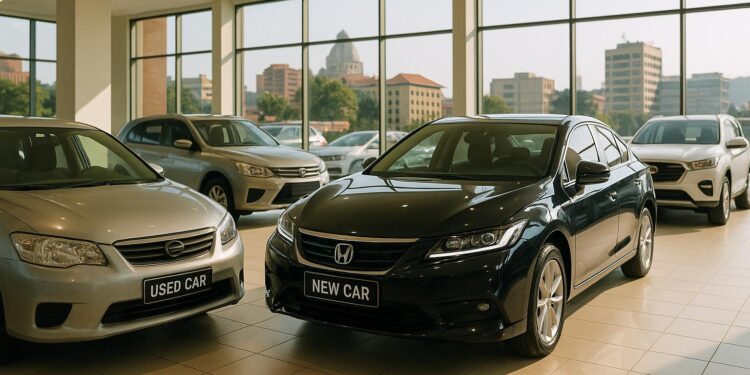Uganda’s car market in 2025 offers two main options: used cars and new cars. Each comes with its own pricing trends, benefits, and challenges. Here’s what you need to know:
- Used Cars: More affordable upfront but rising in price due to import restrictions on vehicles older than 15 years. They remain popular for their lower insurance premiums and slower depreciation. However, maintenance costs can vary depending on the car’s age and condition.
- New Cars: Higher initial costs driven by import duties and global supply chain issues. They offer advanced features, fuel efficiency, and warranties but depreciate faster and come with higher insurance and registration fees.
Key factors affecting car prices include import duties, currency fluctuations, and global shipping disruptions. The Uganda Revenue Authority’s new policy requiring local cargo insurance has slightly reduced import costs, but challenges like the Red Sea conflict and stricter import rules continue to impact pricing.
Here’s a quick comparison of the two options:
| Factor | Used Cars | New Cars |
|---|---|---|
| Initial Cost | Lower upfront cost | Higher upfront cost |
| Depreciation | Slower depreciation | Faster depreciation |
| Maintenance | May require more frequent repairs | Lower maintenance needs with warranties |
| Insurance | Lower premiums | Higher premiums |
| Features | Basic or older technology | Latest safety and tech features |
Your choice depends on your budget and priorities. Used cars are ideal for cost-conscious buyers, while new cars suit those seeking modern features and reliability.
BEST 2025 NEW AND USED CARS PRICES OFFERS IN UGANDA KAMPALA IS OUT🇺🇬
Current Price Trends and Market Factors
Uganda’s automotive market underwent noticeable price shifts throughout 2025, influenced by changes in regulations, global supply chain disruptions, and currency fluctuations. Together, these factors are reshaping how vehicles are priced in the country. The Uganda Revenue Authority (URA) introduced policy changes that have directly affected the cost of both used and new cars.
One major adjustment came into effect on February 1, 2025, requiring all car importers to purchase cargo insurance from local Ugandan insurance providers. This move is expected to reduce the overall cost of imported vehicles, addressing some of the persistent price hikes. On the other hand, the ongoing ban on importing vehicles older than 15 years continues to drive prices upward, as buyers are limited to newer – and typically more expensive – models.
External factors like global logistics and supply chain challenges have also left a mark on vehicle pricing. The conflict in the Red Sea region forced shipping routes to take longer, more costly paths, increasing fuel and transportation expenses. Additionally, global supply chain disruptions have driven up manufacturing and parts costs, making even used vehicles more expensive compared to previous years.
The impact of these trends is evident in the pricing of popular car models:
| Model | Year | Used Price (USD) | New Price (USD) | Mileage | Key Features |
|---|---|---|---|---|---|
| Toyota Premio | 2018–2020 | $12,500–$16,800 | $28,500–$32,000 | 45,000–85,000 miles | CVT transmission, fuel-efficient, compact sedan |
| Subaru Forester | 2017–2019 | $18,200–$24,500 | $35,800–$41,200 | 38,000–72,000 miles | All-wheel drive, boxer engine, SUV versatility |
| Toyota Hilux | 2016–2019 | $22,000–$28,500 | $42,500–$48,000 | 55,000–95,000 miles | 4WD capability, diesel engine, pickup utility |
| Toyota Noah | 2017–2020 | $15,800–$21,200 | $31,500–$36,800 | 42,000–78,000 miles | 8-seater capacity, sliding doors, family van |
| Mitsubishi Outlander | 2018–2020 | $16,500–$22,800 | $33,200–$38,500 | 35,000–68,000 miles | 7-seater SUV, MIVEC engine, AWD system |
Currency fluctuations add another layer of complexity. The performance of the Ugandan Shilling against major currencies like the US Dollar and Japanese Yen has a direct impact on import costs, especially when the Shilling weakens.
Between 2012 and 2024, the average import price for passenger vehicles increased at an annual rate of 1.7%, reaching a high of $6,600 per unit in 2023 before seeing a slight dip in 2024.
1. Used Cars in Uganda (2025)
Price Trends
The used car market in Uganda is experiencing noticeable shifts in pricing patterns. By 2025, used Toyota models and other Japanese imports are commanding higher prices. This is largely due to the 15-year import age restriction, which limits the availability of older, more affordable vehicles. As a result, cars with lower mileage are in high demand, pushing entry-level prices even higher.
Factors Influencing Pricing
Several key factors are driving these price trends. The cost of import logistics, including disruptions in shipping routes, directly impacts the expenses dealers face when stocking their inventory. On top of that, fluctuations in currency exchange rates force dealers to adjust their pricing to remain viable. Local regulations, such as mandatory insurance requirements, also contribute to the overall increase in costs.
Value for Money
When it comes to value for money, used cars often stand out. New vehicles lose value quickly, making used options a more budget-friendly choice while still offering reliability. However, buyers should be aware that financing terms for used cars may not be as favorable. For instance, higher down payments are often required, which can offset some of the initial savings.
Ownership Costs
The cost of owning a used car depends heavily on its age and condition. While the lower purchase price of a used car is appealing, maintenance costs can vary. Japanese models, for example, generally have lower maintenance expenses compared to European brands, which may require specialized parts and repairs. Fortunately, parts availability in Kampala has improved, making it easier to find common maintenance items despite rising global costs. Insurance premiums for used cars are typically lower than for new ones, and while older cars may be slightly less fuel-efficient, a well-maintained vehicle can still deliver competitive performance.
sbb-itb-7bab64a
2. New Cars in Uganda (2025)
Price Trends
The year 2025 saw a noticeable spike in new car prices across Uganda. Entry-level and family-friendly models became more expensive, while premium vehicles experienced even steeper price increases. This shift in pricing has sparked interest in understanding the key factors driving these changes.
Factors Influencing Pricing
Several reasons are behind the rising costs of new cars. Among the biggest contributors are high import duties and environmental and registration fees, which add significant expenses to the final price. Additionally, global supply chain disruptions have limited production, pushing prices higher. Unlike used cars, new vehicles are also subject to stricter environmental compliance regulations and registration costs, further inflating their price tags.
Value for Money
Despite the higher prices, new cars come with several advantages. They often include advanced safety features, improved fuel efficiency, and comprehensive warranties, which can make them appealing to buyers. However, the downside is their rapid depreciation and the higher initial costs. This means buyers need to carefully consider whether the long-term benefits outweigh the upfront expense.
Ownership Costs
Owning a new car comes with added financial responsibilities. Buyers face comprehensive insurance premiums, higher registration and licensing fees, and costly authorized servicing. On the bright side, better fuel efficiency in newer models can help offset some of these ongoing costs, making them a bit easier to manage over time.
Pros and Cons Breakdown
Deciding between a used car and a new one comes down to weighing factors like cost, depreciation, maintenance, technology, insurance, financing, resale value, and reliability. Here’s a quick comparison to help you figure out what might work best for your situation:
| Factor | Used Cars | New Cars |
|---|---|---|
| Initial Cost | Lower purchase prices with more flexible financing options | Higher upfront cost with standard financing plans |
| Depreciation | Slower depreciation since much of the value loss has already occurred | Rapid depreciation, especially in the first year |
| Maintenance | May require more frequent repairs and unexpected fixes | Lower maintenance needs, often covered by warranties |
| Technology | Older infotainment and basic safety features | Latest technology and advanced driver assistance systems |
| Insurance | Lower premiums due to reduced vehicle value | Higher premiums reflecting the car’s new value |
| Financing | Shorter loan terms with variable interest rates | Longer repayment periods with promotional financing options |
| Resale Value | Limited resale value, often market-dependent | Better resale prospects if well maintained |
| Reliability | Varies based on previous care and maintenance | Consistent performance with brand-new components |
Used cars are appealing if you’re looking for affordability and lower insurance costs. On the other hand, new cars stand out for their cutting-edge features and predictable reliability.
Your choice should align with your priorities. If having the latest tech and a worry-free maintenance schedule matters most, a new car might be the way to go. But if you’re focused on saving money and don’t mind a bit of wear and tear, a used car could be a smarter fit for your budget.
Conclusion
Looking at the market trends and cost breakdowns, it’s clear that Uganda’s car market in 2025 offers opportunities for both used and new car buyers, each catering to different financial needs and preferences. Whether you’re seeking affordability or long-term reliability, the market has something to offer for everyone.
Choosing between a used or new car ultimately comes down to your financial situation and priorities. If you’re working within a limited budget and don’t mind occasional repairs, a well-maintained used car can deliver great value. On the other hand, if you’re drawn to the peace of mind that comes with warranties, cutting-edge features, and lower maintenance risks, a new car might be worth the higher upfront cost, especially when factoring in potential savings over time and better resale value.
Whichever route you decide to take, doing your homework is essential. AutoMag.ug is here to help with detailed guides and insights to support you in making a decision that fits your budget and long-term goals. With the right information, you can drive away with confidence, knowing you’ve made the best choice for your needs.
FAQs
How do import laws and global supply chain issues impact car prices in Uganda?
Import laws and supply chain issues significantly influence car prices in Uganda. One key factor is the restriction on importing vehicles older than 15 years, which pushes prices higher since newer models naturally come with a heftier price tag. On top of that, global supply chain disruptions – intensified by the pandemic – have driven up the costs of car parts and shipping, adding to the overall expense.
Shipping rates have climbed as well, largely due to logistical hurdles like restricted access to critical shipping routes. Together, these challenges impact the cost of both new and used cars, making it crucial for buyers to weigh their budgets and options carefully.
What are the financial pros and cons of buying a used car versus a new one, including maintenance, insurance, and resale value?
When deciding between a used car and a new car, there’s a lot to think about financially. A used car usually costs less upfront, making it a more affordable choice at the start. But keep in mind, older cars might come with higher maintenance costs due to wear and tear from previous use. On the flip side, new cars often have fewer repair needs early on, though they come with a steeper price tag.
Insurance is another factor to consider. Since used cars have a lower market value, their insurance premiums are often cheaper compared to new cars. As for resale value, new cars lose value quickly during the first few years, but they may hold onto more of their worth over time compared to older used vehicles.
In the end, your choice should match your budget, how long you plan to keep the car, and how comfortable you are with the potential upkeep costs.
How does the Uganda Revenue Authority’s updated local cargo insurance policy affect car import costs?
The Uganda Revenue Authority’s recent policy on local cargo insurance has added extra costs for those importing cars. Under this policy, importers are now required to buy insurance from local providers, which can raise the total expenses involved in bringing a vehicle into the country.
The actual cost increase varies based on the car’s value and the specific insurance rates, so buyers should account for this when budgeting for a vehicle purchase. While the policy is designed to benefit local insurance companies, it could slightly increase the price of imported cars for consumers.
Related Blog Posts
- Cheapest used cars in Uganda 2025
- Most popular cars in Uganda
- Car maintenance costs in Uganda
- How Much Do Cars Cost in Uganda in 2025? Full Guide




